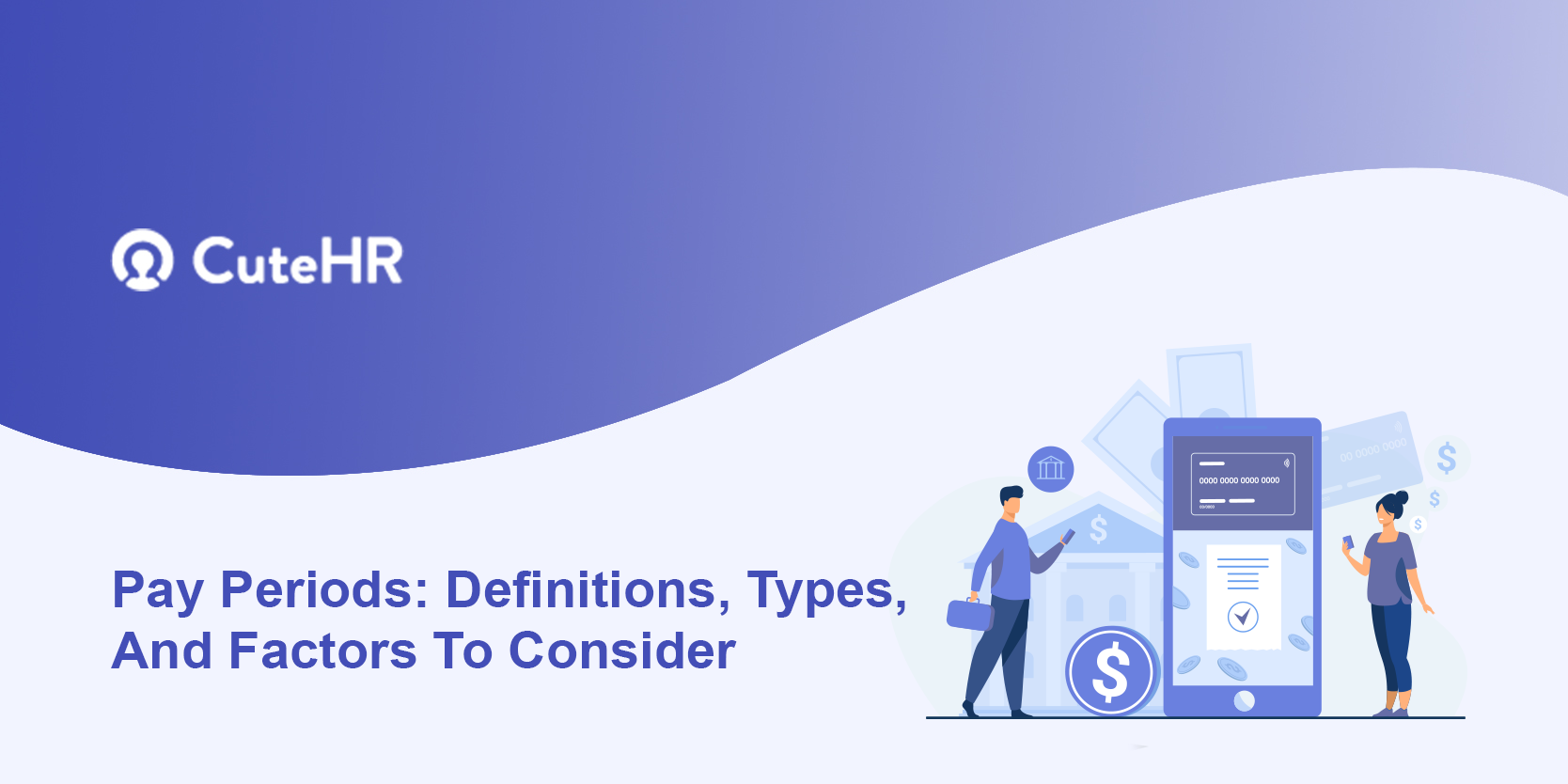01 Apr

Did you know Biweekly is the most common length of pay periods, with 36.5 percent of U.S. private businesses paying their employees every 2 weeks?
How you handle the structures used to pay your staff is a critical choice in the operation of your organization. A well-planned pay period will help you stay in compliance with tax and labor regulations and satisfy payroll obligations on a consistent basis.
In this blog, you’ll get to know more about pay periods, how they work? And how are they divided? And many more, so buckle up and don’t miss any of it.
Table of Contents
What are Pay Periods?
A pay periods is a time frame for calculating earned earnings and determining when employees get their paychecks. Pay periods are usually fixed and recurring on a weekly, bi-weekly, semi-monthly, or monthly basis.
It’s critical to note that the pay periods are not the same as the workweek. The workweek is a nationally regulated, defined time of 168 hours – or seven consecutive 24-hour periods – that a business must follow in order to comply with the Fair Labor Standards Act (FLSA). A workweek can begin on any calendar day and at any time during that day, and the FLSA allows employers to set different workweeks for different employees or groups of employees. The fundamental aim of a workweek is to guarantee that overtime is paid equally and appropriately regardless of pay periods type.
Pay Dates vs. Pay Periods
The employee does not get his or her check at the end of the pay periods, but rather several days after it has ended, which is known as the pay date. Pay date requirements are determined by states, not the FLSA. The number of days an employee must wait for payment for earned wages after pay periods have finished varies by state.
In Massachusetts, for example, employees must be paid within six days of the end of the pay month. Human resource professionals advise leaving at least five days between the end of the pay cycle and the pay date. This gives time for payroll to be properly and precisely prepared, regardless of holidays, vacations, or unanticipated circumstances, and ensures accurate and timely reporting requirements are met.
What Are The Different Types of Pay Periods?
The length of time between two paydays determines the kind of pay cycle. Pay periodicity is determined by a variety of circumstances affecting both the company and the employees, and the following are the most typical pay intervals.
1. Monthly pay periods
According to a year-old government poll, the monthly pay period is the least prevalent in the United States. Only 4.7% of firms stated that they pay their employees every month. According to the same report, small business owners are more likely to use this form of the payroll system and often pay their employees on the last day of the month.
A monthly pay cycle indicates that an employee will get 12 paychecks throughout a calendar year.
The Department of Labor approves state regulations regarding pay frequencies in each state in the United States. Employers are permitted to determine the pay period in many states.
In Iowa, for example, there is no set pay period that employers must follow, although employees must be paid at least once a month. Regardless of whether they are hourly or salaried employees, their payday cannot be more than 12 days after the pay period in which they received their compensation.
Alaska, California, Illinois, Michigan, Nevada, North Dakota, Washington, and other states have a monthly pay schedule (under certain conditions).
Pros:
- It is the easiest for employers to handle.
- Time-saving and cost-effective.
Cons:
- Can be used for paid staff but not for hourly workers.
- Employee budgeting is not ideal.
- Due to bank holidays, dates may need to be altered.
2. Semi-monthly pay periods
Your HR department will need to conduct payroll twice a month if you have a semi-monthly pay period. One pay period is half a month-long and might extend from June 1 to June 15, for example, whereas the second period ends at the end of the month.
Because the number of days in one pay period is determined by the number of days in a month, the duration of the pay period may vary. This is especially true in February, as it is the shortest month. You must also pay notice every leap year since you will have an extra day in February.
A semi-monthly employee will receive 24 paychecks in a calendar year. Arizona, Delaware, Hawaii, Kentucky, Maryland, New Mexico, Virginia, and other states allow you to pay your staff semi-monthly.
Pros:
- Employees and employers are always aware of payroll dates.
- A consistent and regular timetable, with no leap-year difficulties
Cons:
- Calculating overtime might be difficult.
- It is most effective for exempt paid staff.
- Workweeks do not necessarily correspond to pay cycles.
- Due to bank holidays, dates may need to be altered.
3. Bi-weekly pay periods
Unlike the semi-monthly pay period, which is determined by the number of days in a month, the duration of the bi-weekly pay period is always the same – two weeks.
You may see, however, that certain years will have an extra pay period. This occurs every four years, when your employees will have 27 paydays instead of 26 owing to February having 29 days, increasing the number of pay periods for this sort of schedule by one.
For many firms, a bi-weekly timetable is an excellent answer. Employees like the more regular cash flow since it allows them to access their pay and wages more frequently.
The predicted number of paydays and amount of time between two paydays, on the other hand, allows the employer time to perform their budgeting and payroll procedures in a more structured manner.
In the following states, you can pay your employees biweekly: Indiana, Louisiana, Mississippi, Rhode Island, Virginia, and others.
Pros:
- Employees like being paid more often.
- Works effectively with a high number of hourly employees and is more time and cost-effective than weekly pay.
Cons:
- Accounting might be more difficult throughout the three-pay period months.
- Managing monthly benefit premiums on a bi-weekly basis might be difficult.
- Administrators must pay close attention to pay dates to handle payroll on time.
- The 27th check can have a complex influence on aspects such as achieving employee yearly salary expectations, employer contribution amount, tax and benefit consequences, and so on.
4. Weekly pay periods
Employees are sometimes paid on a weekly basis; their yearly income is divided into 52 installments over the course of a calendar year.
Weekly payroll often implies that employees get their paychecks on the same day of the week every week. Many businesses do it on Fridays because it’s the conclusion of the workweek, and it’s not time-consuming to track employees’ hours this way.
Weekly payments are prevalent in the United States and are permitted in a number of states, including Connecticut, Iowa, Massachusetts, New Hampshire, New York, Vermont, and others.
Pros:
- Employees want regular payouts.
Cons:
- The administration is the most time-consuming.
Pay Periods Examples
Let’s look at how an exempt, salaried employee earning $62,400 per year would be paid throughout the year. Keep an eye on how the quantity in each check varies depending on the structure chosen. It should be noted that this estimate does not take into account employment taxes or benefit withholdings.
Let’s take a look at how two typical pay periods might work with a non-exempt employee earning an hourly rate. She will be paid overtime if she works more than 40 hours in a particular workweek. Let’s pretend the workweek begins on a Sunday, and to make things even simpler, the month begins on a Sunday in this scenario.
From the 1st to the 7th, the employee worked 42 hours, and from the 8th to the 14th, he worked 38 hours. Overtime must be computed separately for each workweek, which means that even if the business uses a bi-weekly pay period, it cannot average those hours together to reach 40 each week.
At her hourly wage of $31, the overtime rate (time and a half of $31) is $46.50. The employee earns $1,333 during week one after working 40 hours at $31/hour and two hours at $46.50/hour. During week two, she works no overtime and earns $31/hour for 38 hours, for a total of $1,178.
If the employee is paid on a bi-weekly basis, just put the amounts from the weekly pay periods together to reach the $2,511 bi-weekly pay period amount. It should be noted that this does not include any tax withholdings or perks.
Pay Periods: Factors to Consider
With that in mind, choose the best pay period for your company by taking into account aspects such as state requirements, the cost of processing payroll, and others, such as the ones listed below.
1. Workweeks
Payroll management for small enterprises may be difficult. Aligning the workweek and pay period simplifies overtime calculations and makes payroll processing easier. Each firm is obliged under the FLSA to define a workweek – a defined period of 168 hours, or seven consecutive 24-hour periods.
For non-exempt employees, each workweek is used to calculate overtime. For example, if an employee is paid biweekly and works 30 hours one week and 50 hours the following, she must be compensated for 20 hours of overtime in the second workweek at no less than time and one-half her usual rate of pay.
If it is allowed to pay an hourly employee on a semi-monthly basis, workweeks may overlap pay periods, which means that overtime compensation may cover multiple pay periods.
2. Employment laws and regulations
Federal regulations simply require that wages be paid for hours worked; they do not define when or how wages should be paid.
Some states have stricter restrictions regarding when and how hourly employees must be paid. Before settling on a pay period structure, carefully study all wage and labor rules in the states where you conduct business.
3. Overtime
Considering whether your employees are FLSA exempt or non-exempt can assist you in staying in compliance with overtime obligations and cutting down your pay period options.
A company with a large number of non-exempt hourly employees may benefit from selecting pay periods that simplify the computation and payment of overtime.
Semi-monthly pay periods can be difficult to manage in terms of compliance with state rules for paying hourly employees as well as properly and effectively calculating overtime compensation.
4. Payroll expenses
A major payroll worry is understanding the costs connected with the procedure. Compensation plus any employer-paid employment taxes and the employer-paid component of benefits are included in the costs.
Total payroll expenditures can account for up to 50% -60% of a company’s total operating costs. There are other fees involved with payroll processing, particularly if it is done through a third-party payroll provider, which normally charges for each payroll cycle.
5. Withholdings
The IRS mandates that certain amounts be deducted from employees’ paychecks. Calculating it is complicated, and guidance varies – and payment must be paid on a set schedule – either monthly or semi-monthly, depending on the overall tax burden of the firm.
In 2020, the IRS issued a new version of the W-4 form intending to lower complexity while boosting the openness and accuracy of the withholding system.
It replaces the spreadsheets in the previous form with questions meant to make proper withholding determinations easier for employees, and it includes new guidelines for employers on ensuring that adequate federal income tax is deducted.
Withholdings are complicated, and the rules and procedures are subject to change. As a result, many businesses prefer to utilize payroll software to manage taxes and withholdings.
The systems can compute withholdings and execute payroll, all while ensuring compliance and accounting for factors like as complicated pay structures and multi-state operations.
6. Employee requirements
Consider how a pay period structure may aid in employee satisfaction. Approximately two-thirds of employees say they wish they had had had access to their earned money sooner to settle bills and unforeseen needs. Moreover half of those polled said financial worry keeps them from focusing on their work.
Furthermore, the majority of employees (70 percent) prefer more frequent payment and think it would be difficult to meet financial responsibilities if their next paycheck was delayed by a week.
7. Reporting
Companies are responsible for documenting and reporting labor law and employment tax requirements. Consider how the pay period(s) you select will assist you in adhering to reporting obligations.
Employers are required under the FLSA to keep records for each covered, nonexempt worker, which must include accurate information on the hours worked and earnings earned. Among the details that a company must keep are the total wages paid per pay period, as well as the date of the payment and the pay period covered.
The IRS requires companies to record wages, tips, and other forms of remuneration received to employees by completing the appropriate form (s). Employers who withhold federal income tax, social security, or Medicare taxes are required to submit Form 941, Employer’s Quarterly Federal Tax Return.
Determination of Pay Periods
An organization chooses the pay period structure that best suits the sort of work it does, the demands of its employees, the labor regulations in the area where the firm operates, and other criteria.
It’s also worth noting that the company can designate separate pay periods for different sorts of employees. It is not commonplace for a company to pay hourly employees weekly or biweekly, and salaried staff semi-monthly or even monthly. However, to remain legal, the pay period must be applied consistently to salaries received throughout the calendar year.
Organizations that must stay FLSA-compliant have at least two workers and a $500,000 annual dollar volume of sales or business done, as well as hospitals, companies that provide medical or nursing care to residents, schools and preschools, and government entities. Even though there is no regular, employees are protected under the FLSA if their employment affects interstate commerce on a regular basis.
Mistakes to Avoid During Pay Periods
Payroll errors may result in fines and disgruntled employees. The US Department of Labor collected $322 million in back pay due to workers in fiscal year (FY) 2019. In FY 2020, employees owed an average of $1,120 in unpaid pay. The following are some examples of common payroll errors.
1. Failure to deposit employment taxes in full and on time
One of the most difficult payroll difficulties is calculating appropriate withholding for regular and supplementary pay. A firm must pick which deposit schedule for social security and Medicare taxes to utilize at the start of the calendar year – monthly or semi-weekly – depending on the total tax liability indicated on Form 941. (the quarterly federal tax return). Penalties are imposed for late payments, which rise in proportion to the amount of time they stay unpaid.
2. Failure to appropriately calculate and pay over time
The majority of the money collected by the Department of Labor is due to companies failing to pay time and a half. In the fiscal year 2019, unpaid overtime amounted to $186 million in recovered earnings.
3. Failure to maintain correct records
Employers are required under the FLSA to preserve pay records for three years, and certain states may demand even longer. Accurate records also assist ensure that personnel is appropriately designated as exempt, non-exempt, or independent contractors, allowing your company to stay in compliance with labor and tax rules.
Wrapping It Up
Understanding the differences between pay periods and how they apply to your company model will be critical in making broader financial decisions. The good thing is that once you’ve decided on a technique and begin using it, payroll isn’t that difficult, and there are plenty of tools available to help you handle any problems that arise.
Frequently Asked Questions (FAQs)
Which of the following are the four most usual pay periods?
Weekly, bi-weekly (every two weeks), semi-monthly (twice a month on a specific day), and monthly are the four most typical pay periods (once a month).
How long is a pay period?
The number of weeks in a pay period is determined by the employer’s pay cycle. There are seven days in a weekly pay cycle. Employees are paid every two weeks during a bi-weekly pay period.
Employees in a semi-monthly pay cycle are paid every 15 days, unless the payday comes on a weekend, in which case payroll is normally done the day before. Employees are paid once a month during a monthly pay period, generally on the final day of the month.












Himani